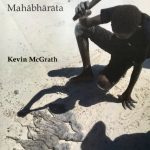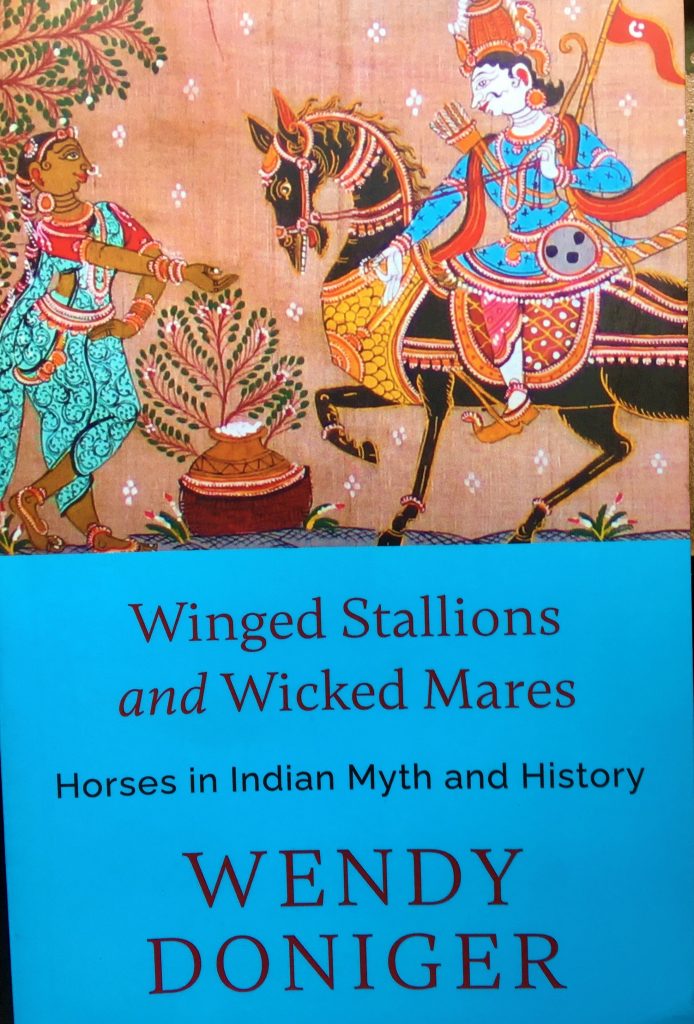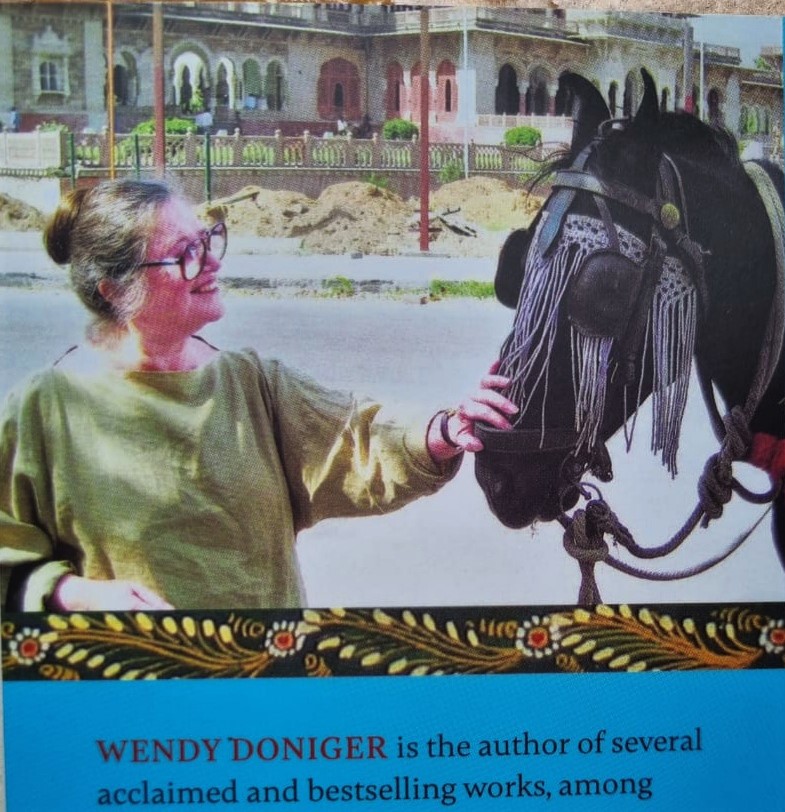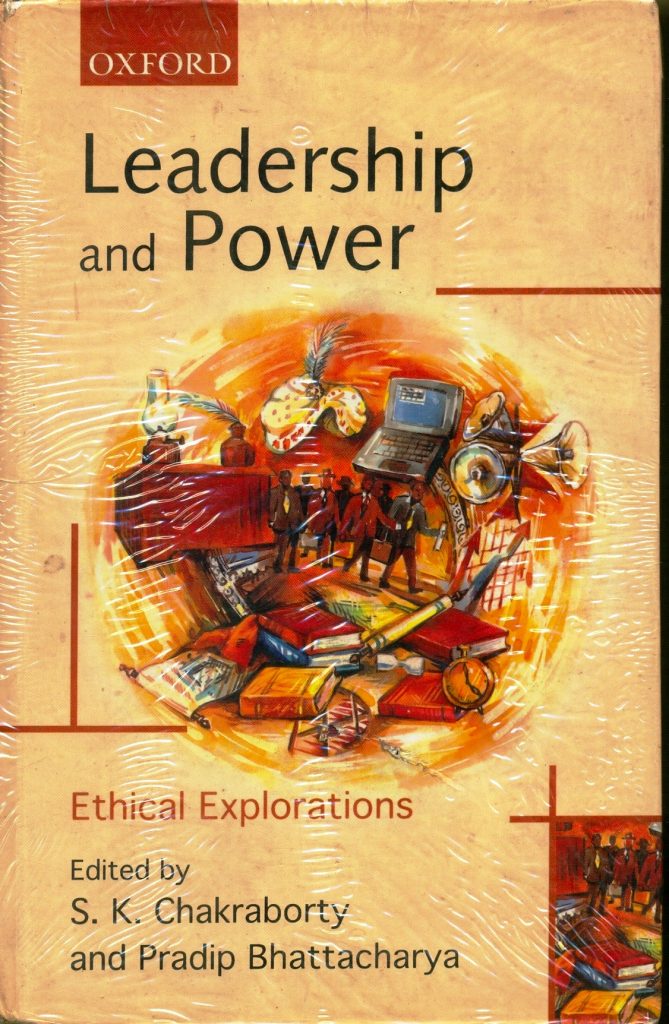Vasanthi Srinivasan: Virtue and Human Ends: Political Ideas from Indian Classics. Orient Blackswan, 2021, pp.202, Rs. 685/-
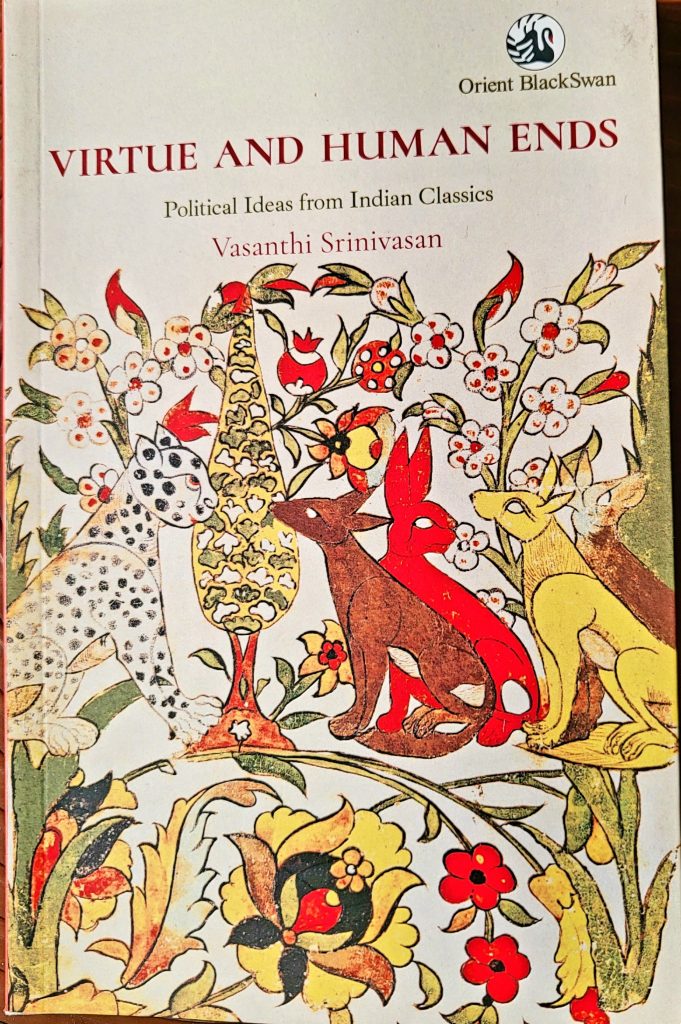
Studies abound of Arthashastra, Mudrarakshasa, Panchatantra and Hitopadesha; not so many of Dasakumaracharita, Vetala Panchavimshati and Simhasana Dvatrimshika, (2nd century BCE to 13th century CE). Srinivasan is the first to study them together vis-a-vis Western political thought. It is the first study based upon Telegu translations which provide different versions of some tales.
Dasakumaracarita is unique for its unstinted praise for niti–shastra that is not found even in the Arthashastra. However, this is undercut by a parody mocking Kautilya’s tenets as too demanding and urging study of other disciplines because statecraft is uncertain, is the root of all anxiety and a hindrance to pleasures like hunting, gambling, drinking and women which bolster manhood and enlarge the circle of friends. In Mudrarakshasa the king’s orders about a festival are countermanded by Chanakya. Both Panchatantra and Dasakumaracarita depict counsellors losing favour because kings suspected powerful ministers. Srinivasan mentions how Plato failed with Dionysus of Syracuse whereas Chanakya succeeded with Chandragupta. Real politik, however, is often found to support tyranny and sophistry.
Panchatantra teaches that practical wisdom must govern power. It specially celebrates friendship, embracing allies (mitra), well-wishers (suhrid) and personal friends (sakhya with a sakha). It not only depicts political situations where deception by inferiors subverts the stronger, but also the bonding of heart to heart. Friendship is possible only between equals, with dharma hardly playing a role. Any wide gap militates against friendship e.g. with kings and gods. The instance of Prince Hal abandoning Falstaff is an excellent example that Srinivasan cites. She appropriately compares with what our epics depict. However, instead of the Sugriva-Rama alliance, she selects the Rama-Hanuman relationship, which is more of master and devoted servant. The Drona-Drupada relationship focuses on equality as the basis of friendship, further explored in the Duryodhana-Karna pair. Again, instead of Krishna-Arjuna, Srinivasan includes Krishna-Sudama where classmates change into bhakta and Bhagwan.
In Panchatantra, Damanaka represents the amoral politician; Karataka the prudent statesman. Virtue is no guarantee against harm (Indra treacherously kills Vritra after swearing oaths of friendship). A good friend surpasses blood relatives. Wives and sons should not be trusted. The touchstone of friendship is help extended in danger. However, Francis Bacon pointed out how princes endanger themselves by promoting their inferiors to become close friends, as with Sulla and Pompey and Caesar and Brutus.
Srinivasan notes how Aristotle extols friendship as the best means of using practical reason as it requires bravery in speaking one’s mind, moderation, justice etc. Although justice is not a pre-requisite for friendship, it is needed where the former exists. Law-makers need to stress friendship between citizens more than justice because friends meet the demands of justice without the need for punishment or persuasion. The superiority of Panchatantra/Hitopadesha to Aristotle, Cicero and Bacon lies in conveying teachings through highly entertaining tales instead of lecturing on morality or policy.
Poverty is seen as the root of all evils and mendicancy is as terrible as death, thus denigrating Jain and Buddhist bhikshus. Srinivasan asserts that charity is considered dreadful and a door to death, but fails to cite any instance of this. Hitopadesha conversely condemns hoarding without donating. Donation, dana, is extolled in the Mahabharata as the sure path to heaven. There is a fascinating debate on individual enterprise and dependence on fate, with karma determining what is one’s due. The texts are scornful of Brahmins but extol merchants as wise, righteous and ambitious, indicating the social perspective. Caste is not a social barrier. A weaver seduces a princess and gets the kingdom.
The discourse of the turtle Manthara incorporates both secular adages on policy and spiritual advice from the Gita, revealing how decisions are reached. Maxims are not to be followed mechanically, specially where an enemy approaches as a friend. The story of an owl raiding crows’ nests should have reminded Srinivasan of that scene witnessed by Ashvatthama in the Sauptika Parva of the Mahabharata. There are many depictions of women as foolish, greedy, selfish and lustful. However, they are also shown as intelligent, practical, contented and interested in discussing morality. Feminine friendship is featured besides male bonding.
Srinivasan expands the ethical dimension in Arthashastra which is usually neglected by academicians. War is only the last resort. Instead of abstract morality, it is practical steps for survival and winning wealth that are advocated, including using spies and occult practices, not hankering after glory and honour. However, if Kautilya were to be followed, the weaker Pandavas would not have fought the stronger Kauravas, Alexander would not have attacked Darius’ and Porus’ superior forces and invaders would not have fought at Panipat.
Where power-drunk rulers ignore rational decision-making, what is to be done? Panchatantra and Hitopadesha stress Kautilya’s policy of negotiating peace while preparing for war, and note how wars may be arise from trifles because of meddlers. In the story of the owls and crows, Stirajivin’s suggestion of staging a mock-quarrel and withdrawing out of sight echoes how the Achaeans deceived the Trojans. Srinivasan cites Pakistan’s use of the “double policy” of having bilateral agreements while fostering armed intrusions and terrorist strikes.
Hitopadesha specifically warns against simplistic action based just on courage and strength and text-book maxims without practical experience. It advocates tempering strength with prudence, recommends that the good ally with one another and shows that displaying indiscriminate good will to all brings destruction. It upholds not peace at any cost, but peace with honour as the goal. Goodness is understood as consisting of trust, honesty and friendship with one’s ally.
The tales of the ten princes detail acquiring wealth and women regardless of dharma. Only two stories (Arthapala and Vishruta) praise dharma above kama. The rest tell of acquiring princesses and kingdom through daring and immoral means. In Dandin love is exclusively sexual, rivals spiritual bliss and demands immediate consummation, spurning all obstacles. All becomes commendable when used by the talented. This recalls Bhishma telling Draupadi when she is being molested in the court that whatever the mighty do is dharma. Conveniently, Ganesha is introduced to sanction fraud, and examples are cited of Shiva seducing rishis’ wives, Brahma lusting after his daughter, Brihaspati violating his pregnant sister-in-law, Parashara forcing Matsyagandha, Indra’s adultery with Ahalya, Vyasa impregnating his brother’s wives and Atri having coitus with a doe.
Women are as complicit as men in these intrigues. Prostitutes and rogues abound in Dasakumaracharita. Monarchy depends on the ruler’s ability to succeed, not just on intelligence, courage and morality. The tale of Vikatavarman being deceived by a female sanyasi to participate in a yajna to acquire beauty, only to be murdered, recalls Euripedes’ Medea. Kamamanjiri seducing the sage Marichi and bringing him into town recalls the tale of Rishyashringa’s seduction by courtesans in the Ramayana and the Mahabharata. The training of courtesans and princes is very similar.
Dandin’s women are clever, murderous, worldly-wise and enterprising, e.g. Dhumini and Gomini. The latter resembles the Jataka tale’s mouse-trader. The story of Nimbavati winning back her husband is like Shakespeare’s “All’s Well that Ends Well.” Srinivasan points out how it resembles Silappatikaram with trader husbands neglecting chaste wives for prostitutes and how wives strive to win back their love. She notes that Dandin’s world is akin to Machiavelli’s play Mandragola, both showing up the fragmentation of virtue in corrupt society and advocating practical compromises, apad-dharma (the ethics of emergencies). The chaste wife succeeds by her wits, not by undergoing a fire-ordeal like Sita. The redeeming feature is that Dandin gets all his heroes married, like Shakespeare in his Dark Comedies.
Pointing out the “doubling motif” in these texts (Chanakya-Rakshasa, Damanaka-Karataka, Chakravaka-Doordarshi and Vishruta-Aryaketu), Srinivasan shows that the loyalty and humanity shown by one in each pair prevents him from ruthless acts of self-interest. Such qualities are needed in normal times for establishing legitimacy and trust. By reconciling the characters finally, the texts show their understanding of “the chameleon-like nature of political prudence.” One may do wrong for restoring order, but that is preferable to being weak in niti-policy in emergencies. Srinivasan has overlooked Krishna doing precisely that in the Mahabharata, where he also specifies when not being truthful is justified.
The tales of Vikrama-Vetala are also erotic escapades but are distinguished by the importance accorded to morality. The text targets the urbane, cultured aesthete with ample leisure to indulge in wine, women and song. Vikrama is usually asked to decide who is nobler. Srinivasan concentrates on five tales about outstanding nobility and how they relate to proper conduct in terms of caste, family tradition, duty and the stage of life. This is not the Kantian categorical imperative, but is situational and community-based. This is complicated further by the dharma of crises. Here too women are regarded as more prone to commit evil, lacking instruction in morals. Vikrama’s decisions about nobility are quite sexist, extolling the husband who gives up his faithful wife Madanasena to save himself or suspecting her chastity. There is no concern about building up the state. Srinivasan surmises that the ruler needed to be educated about how to deal with forest people outside the pale of “civilized” society. Vikrama chooses as more noble not those eminent figures who follow their “svadharma,” but ordinary people who forego self-interest to help strangers, acting without any thought of reward. Matters become complicated for us when in Jambhaladatta’s version different persons are chosen as superior from Shivadasa’s. It is all about how to act nobly where traditional duty is ambiguous or unpleasant.
Srinivasan has an illuminating discussion of Boccaccio’s Decameron which also presents models of greatness in intelligence, generosity and patience and reveals the limits of traditional moral standards in evaluating excellence. She finds that Vikrama’s tales go further by exploring the challenges posed by having to retain power when faced with competition. The king cannot assume he is safe because he is good, but needs must remain alert about hidden dangers.
This prudence is, however, disregarded in the 32 tales about Vikrama’s throne. Here the pattern is of a king adventuring in dangerous places to obtain occult powers, which a poor Brahman then takes away. They also stress on nurturing the atman. Here Vikrama neglects royal duties in pursuing adventures and even gifts his occult powers to the resurrected dead sorcerer. King Bhoja is able to ascend this throne only after he asks for no boon.
The post-Arthashastra texts do not just extol self-interest, power and prudence, but add the benefits accruing from friendship. Kautilya’s sixfold strategy is not applied mechanically but after considering the counsel of wise ministers and friends. Bravado has to be reined in by rational counsel. As Hitopadesha stresses, true success is achieving peace between weak and equal powers. Intrigue can be used to forge such peace. Srinivasan feels that feminists can learn much from these texts about women as sexual agents to become more sophisticated about sexual harassment, though she does not elaborate this. They also show how politicians can behave as though they were omniscient, using others as means to their ends. In crises, it is difficult to distinguish statecraft from tyranny and “only the most subtle experts of niti can gauge what is apad–dharma at all.” Although the audience was royalty and the urbane man, the insights on friendship, war and peace, morality and political necessity are remarkable and still relevant.
This slim volume carries a striking cover sketched by “14-year-old Amrit” and a fine bibliography. While the Indian texts are well presented interestingly, the discussions on Western scholarship are rather tedious and too pedantic. The printing is excellent with only one error: on p. 71 Jayadratha is misspelled as “Jayadrata”. The price is disproportionate to the book’s slender dimensions. It is puzzling why Srinivasan left out Tiruvallauvar’s Tirukkural, the earliest didactic treatise to deal with Aram (dharma-virtue), Porul (artha-wealth) and Inbam (kama-love), available in Dr. K.R. Srinivasa Iyengar’s excellent verse translation. She would have benefitted from consulting the splendid English translations of Arthashastra by Dr. Pratap Chandra Chunder (1995), of Hitopadesa (1989) and the Kathasaritsagara (1994) with the Vetala tales by V. Balasubrahmanyan in the M.P. Birla Foundation’s “Classics of the East” series. Kanika-niti, Vidura-niti, Narada’s discourse on statecraft in the Mahabharata and Bhartrihari’s Nitishatakam (translated by Sri Aurobindo as “The Century of Life”) could also have been discussed.
[A slightly different version was published in The Statesman of 17th February 2020 on page 11]
